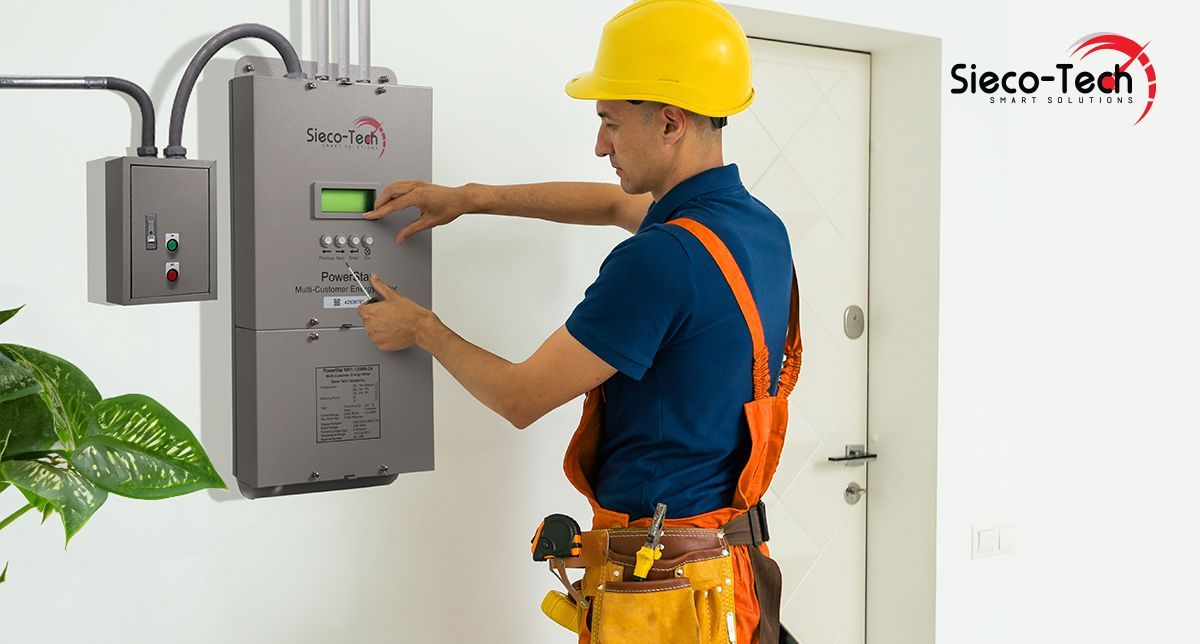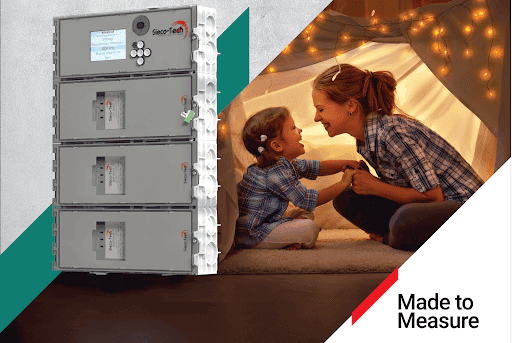
Understanding
S-E-02 Reverification in 2025
Published Nov. 28, 2024 | Updated March 2025
At a glance
- Measurement Canada requires all meters to be initially verified and periodically re-verified to ensure their ongoing accuracy.
- S-E-02 re-verification outlines the verification and reverification testing requirements, all electric meters and electric sub-meters must meet.
- The reverification process involving Measurement Canada’s S-E-02 re-verification can be complex and lead to unexpected costs.
- Partnering with an Accredited Service Provider (S-E-02-compliant supplier) and purchasing from reputable sub-meter brands can prevent meter failures and offer long-term cost protection.
Smart Energy Meters and Electric Sub-Metering
Electric sub-meters are a foundational piece for creating and supporting sustainable, smart tenet real estate. They provide detailed insights into how much energy individual units or zones use, offering a granular level of usage tracking and cost control.
All new multi-tenant developments in Canada now require sub-meters to support multi-tenant billing. Selecting the best electric sub-meters helps to meet strict regulatory requirements and have to pass inspection and periodic reverification to ensure the equipment accurately tracks usage.
Canada’s Regulatory Landscape for Sub-Meters
The Electricity and Gas Inspection Act (EGIA): Enacted by the Parliament of Canada, the EGIA is the legal framework that ensures the accuracy of all meters used in trade measurement applications for electricity and gas, including sub-meters. The EGIA mandates the regular inspection and verification of meters to meet specific accuracy requirements. This protects consumers and businesses alike, ensuring that an end consumer's bill reflects the true energy consumption measured.
Measurement Canada is the federal agency responsible for enforcing the EGIA. Their responsibility includes inspecting meters, verifying their accuracy, ensuring proper installation, and investigating consumer complaints. Their oversight ensures that all meters used for billing applications—whether they are utility meters or sub-meters used in multi-tenant applications—comply with strict accuracy requirements. This protects both consumers from being overcharged and metering businesses from underbilling for services rendered.
Electricity and Gas Inspection Regulations: These regulations provide detailed requirements for compliance with the EGIA, covering everything from type approval to sealing and verification. Meters used for trade measurement or revenue metering purposes must meet these stringent regulations to be legally operational.
What to know about S-E-02 Sub-Meter
Reverification Requirements
The Electricity and Gas Inspection Act (EGIA) states that all meters used in trade measurement must be initially inspected and periodically re-inspected to ensure they comply with the legal requirements for accuracy and performance.
Measurement Canada’s S-E-02 Re-Verification covers the verification and reverification testing requirements for electrical meters, including sub-meters used in multi-tenant metering applications. This specification ensures that these meters remain compliant (accurate) over their life expectancy and continue to comply with the EGIA legal requirements for billing purposes.
S-E-02 reverification inspections confirm that sub-meters continue to comply with requirements in design, performance, features, functions, and markings. Let’s break down the key elements of this specification.
What Does S-E-02 Mean?
- “S” stands for Specification, indicating the technical standards or processes the document lays out.
- “E” represents Electricity, differentiating this specification from those that apply to gas or water meters.
- “02” is the document’s identification number within this series, specifying that it’s the second regulation related to electricity meters.
The S-E-02 Verification and S-E-02 Reverification Process
Initial Verification
Before a sub-meter is sold or put into service, it must undergo an initial verification process to ensure it meets Measurement Canada’s performance standards under S-E-02. This involves inspecting and testing the meter to confirm, among other things, that it accurately measures energy consumption within allowable limits throughout its operating range.
Reverification
Meters may lose accuracy over time due to drift (wear), environmental factors, or malfunction. S-E-02 requires meters to be periodically re-inspected (re-verified) to ensure they continue to function correctly and accurately. This is particularly important for sub-meters that have been in service for extended periods.
For all electric sub-meters, reverification is typically required every 6 or 10 years. The exact length depends on the meter type and its initial accuracy class.
Measurement Canada’s bulletin E-28 qualifies electricity meters for a 10-year lengthened initial reverification period. A meter identified with a “conditional” 10-year reverification period means that Measurement Canada has yet to review performance data for that particular meter type prior to granting an unconditional 10-year period.
Performance and Administrative Standards
Electric sub-meters must meet specific accuracy limits. For example, sub-meters are required to have a performance error of no more than plus or minus 1% when measuring energy consumption.
A sub-meter's calibration accuracy can degrade or drift over its lifetime. Therefore, regular inspections are required to ensure compliance with these technical requirements.
Electricity and Gas Inspection Act (EGIA)
Beyond a meter’s performance requirements, the Electricity and Gas Inspection Act (EGIA) also identifies other administrative requirements and records that must be maintained. Meter Inspection Certificates, metering and inspection records are required to be documented for each meter inspected. Additionally, the EGIA also requires billing records to be maintained to all consumers of electricity or gas.
All meters, including sub-meters once initially inspected, must be sealed by a recognized service provider and be clearly marked with information such as voltage ratings, model numbers, and their verification status. This ensures transparency, identification and helps prevent tampering.
The Most Challenging Components of
S-E-02 Sub-Meter Compliance
Meter reverification under the EGIA can present certain challenges for businesses and property managers, particularly when managing large-scale operations.
Maintaining Regular Reverification Schedules
For businesses with multiple sub-meters, keeping up with reverification schedules is no small feat. Sub-meters in multi-tenant or commercial buildings can require coordination with property managers or tenants in order to grant proper access. Delays in reverification can lead to non-compliance and or penalties with Measurement Canada.
Electricity meter reverification periods for electricity meters and metering installations can be found in Measurement Canada’s bulletin E-26.
Failed Reverification, Repairs & Upgrades
Any meter or meter system (sub-meter) that fails reverification testing must be marked as “non-conforming” and either be repaired or replaced before being placed back in service for billing purposes.
Unexpected Complications
Challenges can arise when it’s discovered that sub-meters are installed in non-compliant or difficult-to-access locations during the reverification process. In some cases, this can escalate into costly reengineering projects, where layouts have to be redesigned to ensure compliance and access.
Additional S-E-04 Verification
All sub-metering systems require an on-site inspection once installed in service to ensure correct installation. When these sub-meters are subjected to the periodic reverification process (S-E-02) they must be removed from their panel for testing. This means the meters or sub-metering systems will have to be reinstalled by a Measurement Canada Authorized Service Provider (ASP) and be re-inspected under the S-E-04 verification requirements to ensure correct installation.
North America's Leading Smart Electrical
Sub-metering Solutions

Newer sub-meters, such as Sieco-Tech’s MCP, offer a plug-and-play modular design which can help deter some of these additional costs.
Any time a typical meter would need to be uninstalled or replaced to be subjected to the reverification process, sub-meters like the MCP allow electronics modules to easily be removed as needed without having to remove any other metering components from the electrical distribution panel.
The MCP features three separate and distinct seals: the Meters Metrological Seal (S-E-02), the Terminal Seal (S-E-04), and the Door (Utility /Meter Owners) Seal.
Tips For S-E-02 Reverification Efficiency
Navigating the challenges of S-E-02 reverification can be easy with the right technology and strategies.
Here are three key approaches to solve common challenges:
1. Leverage Innovative Technology and Design
Investing in high-quality sub-meters from trusted manufacturers ensures better long-term accuracy and durability. Reputable brands often offer more reliable products that can obtain longer reverification intervals, ultimately saving on maintenance costs.
2. Track Reverification Dates Proactively
Set up a reverification schedule well in advance to stay on top of regulatory deadlines. Use automated systems or reminders to track when meters need to be re-verified and prepare templated notices to keep property managers, tenants, or other relevant parties informed.
3. Partner with Sub-Metering Experts
Always work with trusted, licensed sub-metering contractors and consultants who are familiar with local permit requirements and Measurement Canada’s regulations. Sub-metering experts will ensure proper installation, minimize the risk of compliance issues, and provide expert guidance throughout the reverification process.
Made to Measure — Sieco-Tech Is Your Electric Meter
Sieco-Tech is a leader North America's electrical sub-metering industry. Measurement Canada compliant sub-meters that meet stringent S-E-02 initial verification testing but which are guaranteed to maintain Measurement Canada compliance and pass reverification intervals over the lifetime of the metering device.
Upgrade Technology and Save Money
Reach out to Sieco-Tech TODAY to begin your complementary quote and project consultation.